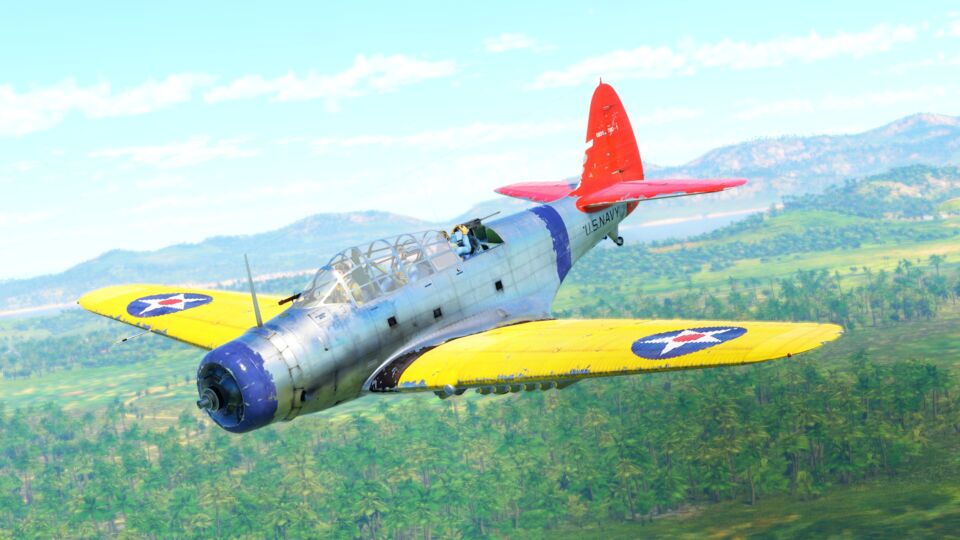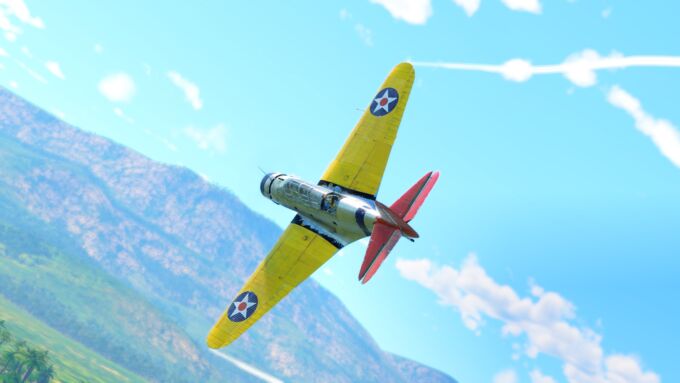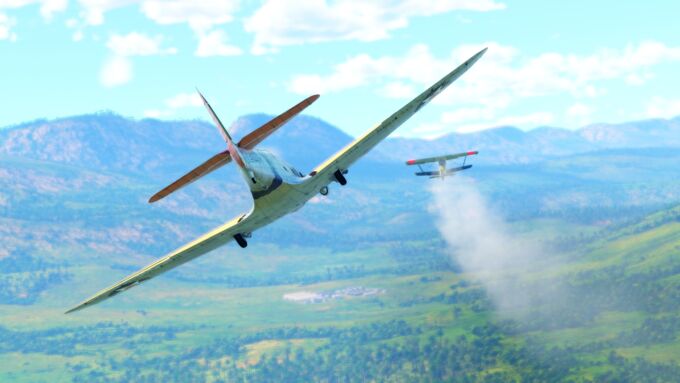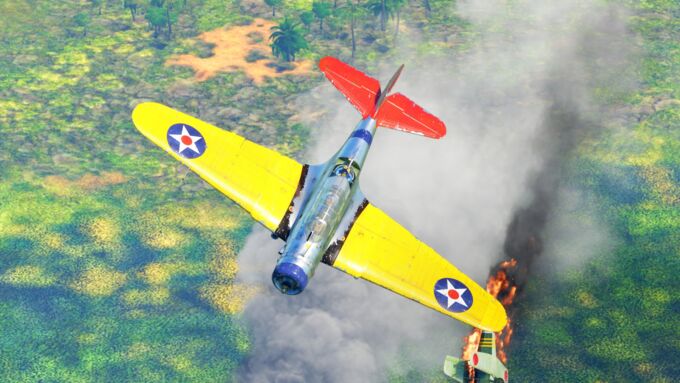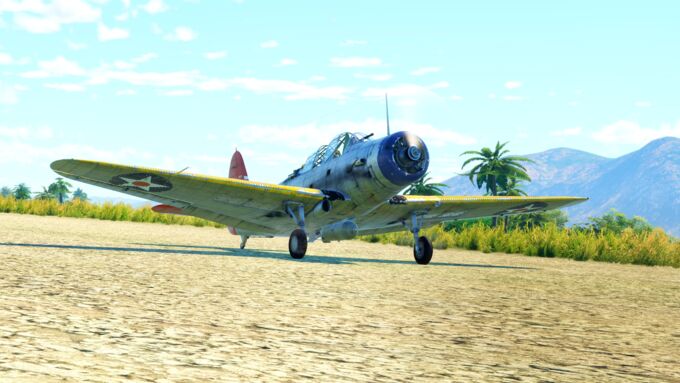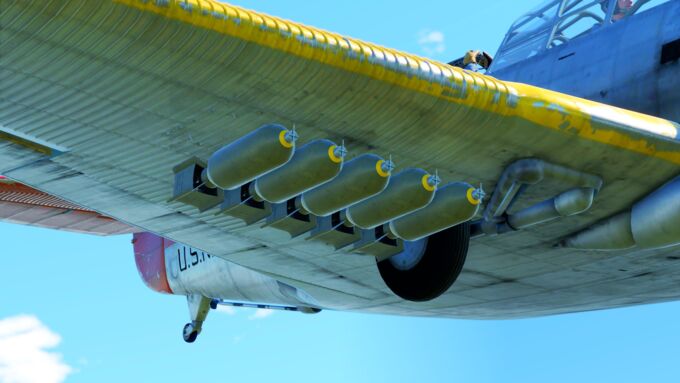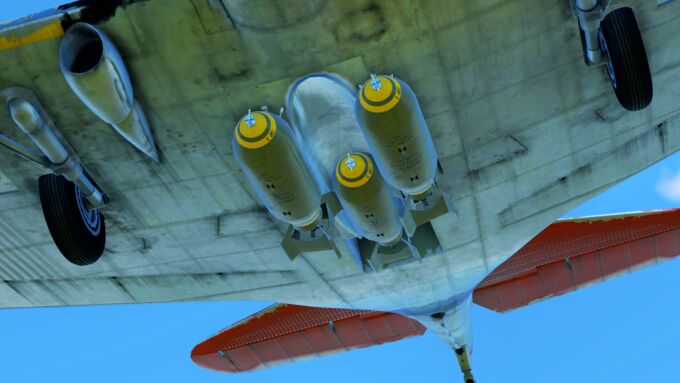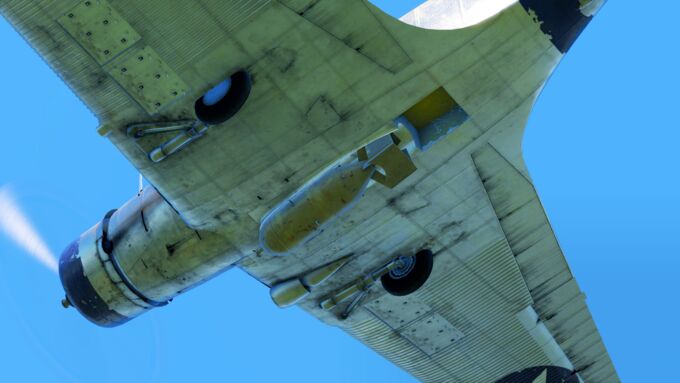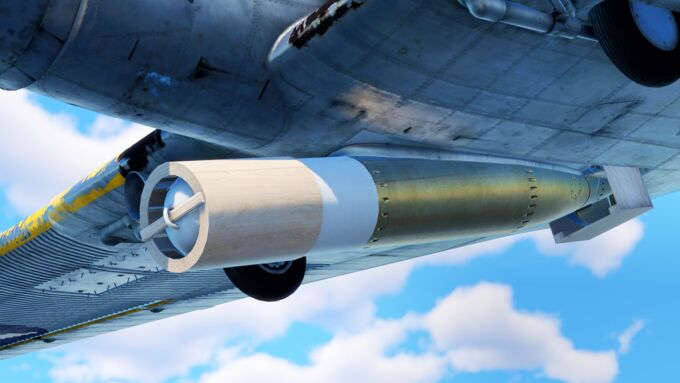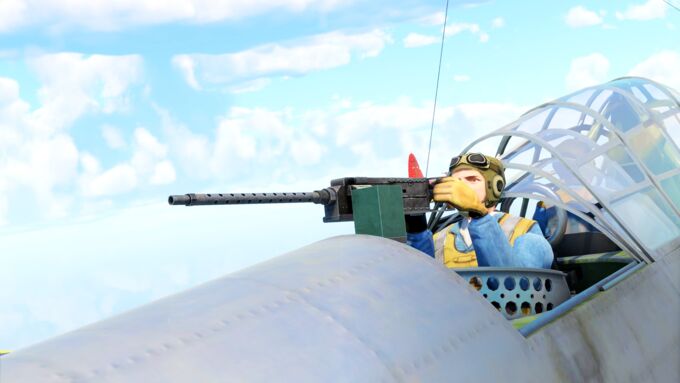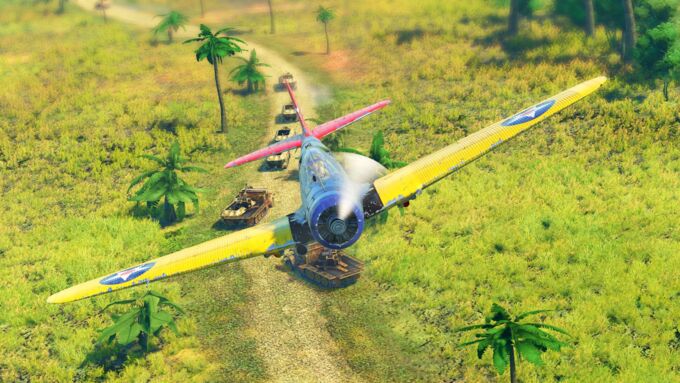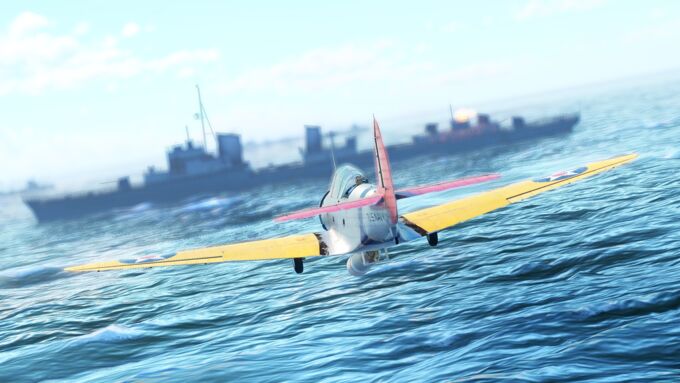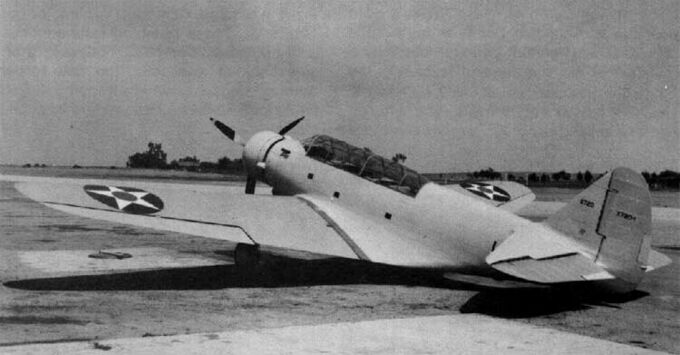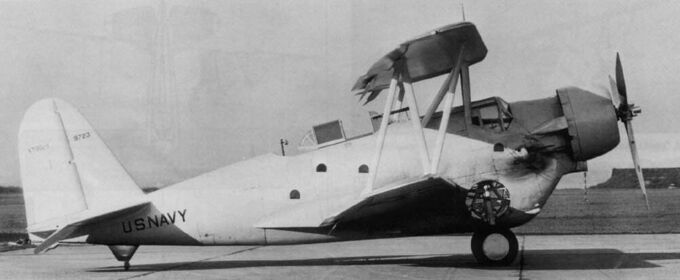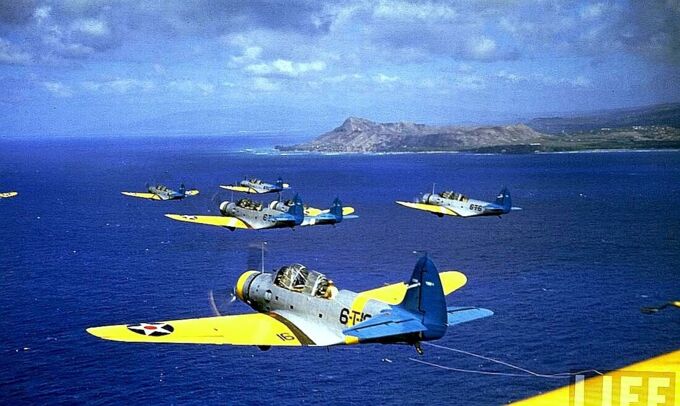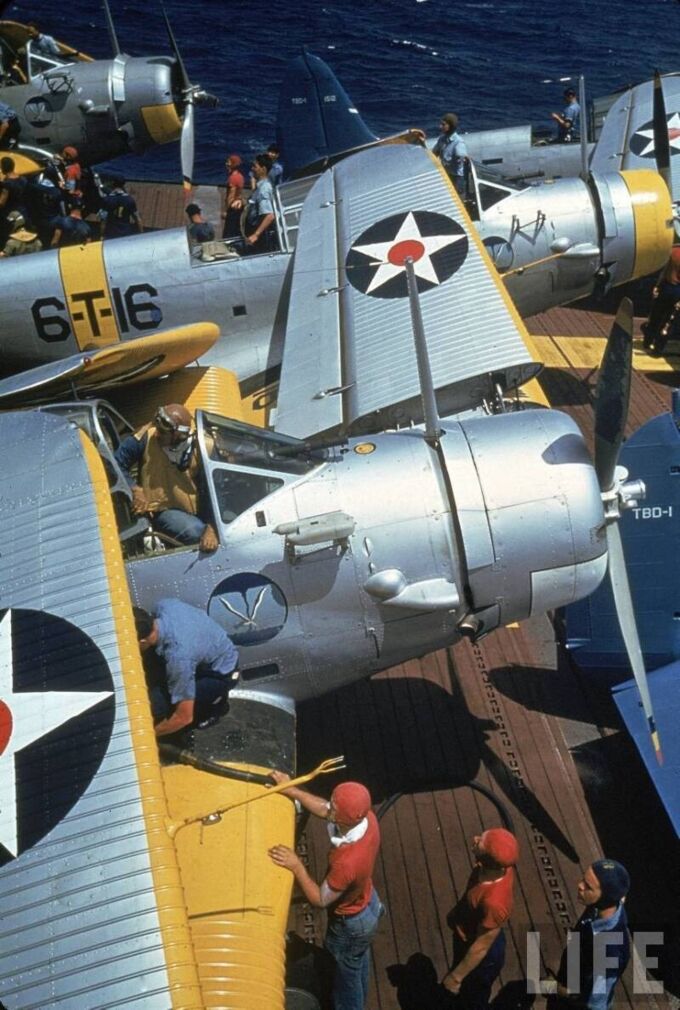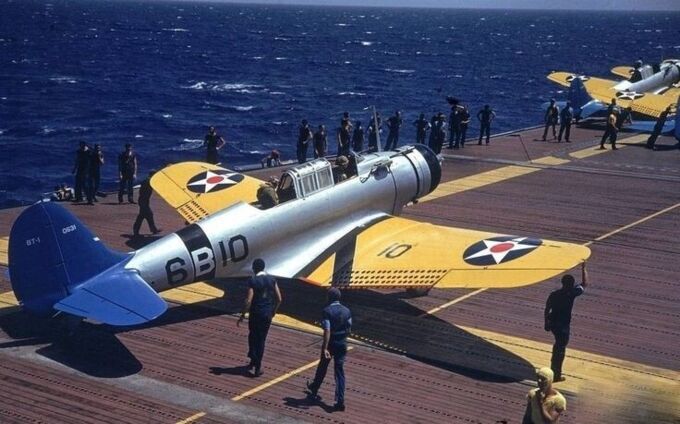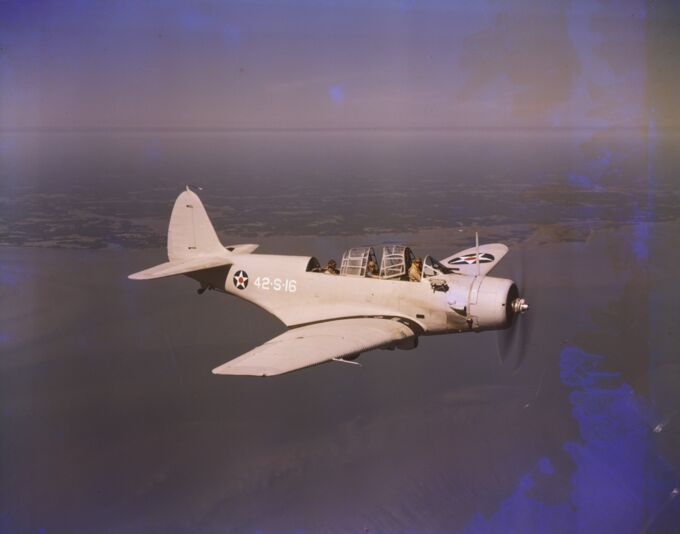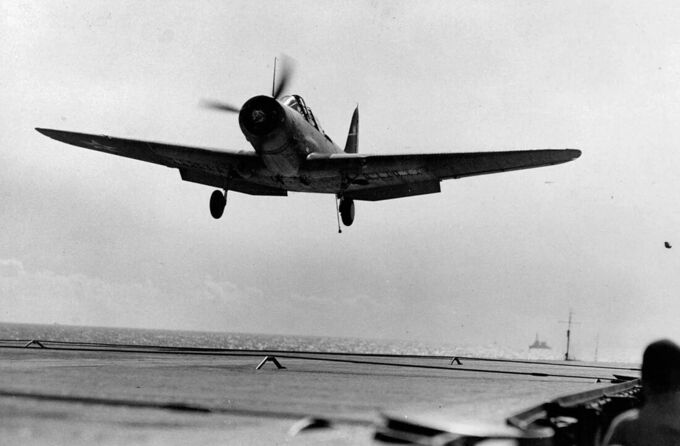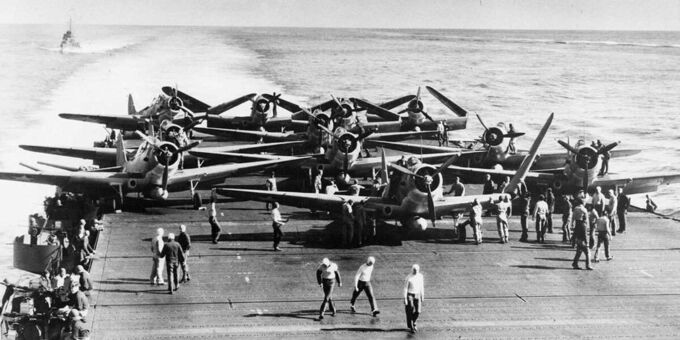The characteristics and capabilities of the TBD-1 Devastator are quite remarkable: like any other American bomber, it is well armed compared to its competitors: it can carry a large number of bombs of different calibers, has a defensive turret with good aiming angles and a large caliber Browning M2 machine gun. All this makes the plane not just an ordinary "bomb hauler", but an almost universal "predator" capable of destroying enemy targets on land, sea and in the air. However, its flight characteristics are not so good. You can read more about the TBD-1 in this article.
| Pros | Cons |
|---|---|
| Decent survivability | Low max speed |
| Big amount of bombs | Just a single offensive machine gun |
| Maneuverability |
Flight performance
- Speed and climb rate: when discussing flight characteristics, the following should be noted: TBD-1 reaches a much lower speed than it seems at first glance. In arcade battles the plane accelerates to a maximum of 327 km/h, in realistic battles — to a maximum of 312 km/h, and this is without taking into account the payload, which subtracts another 20-30 km/h. Taking into account the combat rating, the low speed can even be an advantage: there is more time to aim when bombing, reducing the spread of bombs. But almost every fighter, not only monoplanes, but also biplanes like the German He 51 A-1, can catch up with the BTD-1. The climb rate of the plane is also not impressive, and this indicator of the bomber is only 8 m/s in arcade mode and 6 m/s in realistic mode. It takes almost 3 minutes to reach an altitude of only 1000 meters, but the bomber's climb rate is a secondary characteristic that will not greatly affect the outcome of the battle, especially for reserve and near-reserve vehicles.
- While the speed performance of the TBD-1 is poor, its maneuverability is better. In this respect, the American torpedo bomber is not inferior to other early light and dive bombers, while some aircraft, such as the German Ju 87 B-2 or the Soviet BB-1, have a much worse turn rate. At the same time, the TBD-1 should not engage fighters in a dogfight, as they will generally have much better maneuverability than the slow American torpedo bomber.
- The TBD-1 has the following flight limits: it rips at mere 430 km/h, making it almost impossible to escape from an enemy by diving. The flaps are flimsy and can withstand a speed of just 210km/h. Stall occurs at a speed of 107 km/h and below, so landing the plane on an aircraft carrier will be easy.
Survivability and armour
Aircraft of the 1930s are typically lacking in armor, but the TBD-1 is a pleasant exception. An armored bulkhead in front of the pilot and a 12.7 mm thick steel armored headrest guarantee the pilot protection against rifle-caliber machine guns, which were installed on almost all I-rank fighters. Self-sealing fuel tanks are compact and close to the fuselage, making them difficult to damage, and fires at minimum fuel load are not critical to the aircraft. The Pratt & Whitney R1830-64 air-cooled engine can provide the pilot with an additional defense against frontal attack if absolutely necessary. The engine is capable of surviving multiple hits, but power output will be reduced under such circumstances. With a damaged oil cooling system it is possible to fly for some time, but it is better to return to the airfield if you still can.
In general, the TBD-1 is a tough aircraft in its class. The bomber is quite capable of surviving many hits from rifle machine guns from the front or rear. Yet its better not to get under fire to begin with. Aforementioned armor only partially protects the pilot from attacks from the front and from the rear: there is no armored glass and full armored backrest that could protect the pilot from the two most endangered sides of the aircraft.
Armaments
Offensive armament
The aircraft's offensive armament consists of a single Browning M2 large-caliber machine gun. For the I rank, this machine gun can be considered ideal: simple bullet ballistics allow comfortable shooting at long distances, a good rate of fire of 750 rounds per minute provides sufficient fire density and damage to vital aircraft modules, and armor-piercing bullet penetration of 20 mm at a distance of 500 m provides the ability to ignore any armor protection encountered on the aircraft, as well as to use the machine gun to destroy various lightly armored targets, such as light bunkers and light tanks. In addition to the excellent characteristics of the Browning M2, its ammunition capacity on the TBD-1 is 500 rounds is great and will be enough for both experienced players, who can easily take the required target lead, and beginners, who might have to take their sweet time getting bullets on target.
The Browning M2 is available with an early belts consisting exclusively of armor-piercing, incendiary, practice, and tracer bullets:
- Default: T · Ball · I · AP — It's a pretty decent belt that will do most of the things a pilot would want. It has a tracer round to help with aim, and AP and Incendiary to set enemies on fire or shoot their pilots. Ball is useless, though.
- Universal: AP · AP · AP · T · I — This belt is pretty much alike to the previous one, its just that it has more AP bullets that make it more effective against flying or ground targets.
- Ground targets: T · AP · AP · AP — As the name suggests this belt is most effective against ground or water targets and will be less effective against planes as it lacks incendiary bullets to set enemies on fire.
- Tracers: T · T · T · AP — This belt is probably one of the least effective ones. It lacks incendiary bullets and has very little amount of armour piercing rounds. Though it might help novice pilots learn the ballistics, be it with infuriating amount of no-damage hits.
- Stealth: AP · I · AP — Using this belt a pilot will not have any tracers to help with aim, but it will also make the shooter harder to notice and it actually has a good damage output.
Suspended armament
While TBD-1 is mainly a Torpedo-Bomber, it has a lot to offer in terms of bombs, having a big payload. Moreover, it has a bomb sight to help with aiming. Since now it is possible to edit the payload, it is possible to create an own preset for certain tasks.
- 100 lb AN-M30A1 — the weakest available bomb for TBD-1. It's similar in all characteristics to other 50 lb bombs and it is possible to take 12 of them. The explosive in the AN-M30A1 is 24.5 kilograms of TNT equivalent. To destroy an enemy tank it would be required to drop it right on the enemy. Although any other unprotected vehicle, static object or a landing bomb would surely be destroyed even if the drop wasnt that precise.
- The AN-M64A1 500 lb bomb is the next variant of the suspended armament. Unlike the 100-pound bomb, the 500 lb one is packed with far more explosives, 162.8 kilograms of TNT equivalent, making it easy to destroy virtually any target that might be encountered in combined tank and naval battles, even without a direct hit from the bomb. However, the TBD-1 can only carry 3 of these on the center pylons.
- The GP Mk9 1000 lb bomb is the most powerful bomb available to the torpedo bomber. The GP Mk9 is filled with 335.7 kg of TNT, which makes the 1000-pound bomb equivalent to 3 500-pound bombs in terms of explosive mass, allowing it to destroy any target in combat without a direct hit, but in terms of effectiveness, one GP Mk9 is clearly inferior to three AN-M64A1s. For this reason, the 1000 lb bomb is most effectively used in air battles to destroy bases.
- Mk.13-6 Torpedo — Is worse in every way than Mk.13-6 Case due to the low altitude and speed requirements which will severely limit the ability to dodge enemy AA. Its speed will also not be enough to hit fast-moving torpedo boats.
- Mk.13-6 Case Torpedo — A much faster torpedo (74 km/h against 55 km/h) with a bit lesser travel distance, but also with 7 times higher drop limit (700 meters) and ability to drop it at speeds up to 750 km/h (instead of 200 km/h), which TBD-1 will never be able to reach.
Defensive armament
Against attacks from the rear, the TBD-1 has single dorsal rear turret with a single 7.62mm Browning machine gun. The turret has good vertical angles, although it does not cover the entire upper rear hemisphere. The machine gun itself does good damage against light fighters and has an effective range of 600-700 meters. It has a rate of fire of 1000 rounds per minute and 600 rounds of ammunition. There are only two belt packs available for the machine gun:
- Default: T · Ball · Ball · AP · I
- Armoured targets: T · AP · AP · AP · I
In theory, both belts would be suitable for the machine gun, as the fighters would be simple canvas-covered biplanes or the early unarmored monoplanes, which would only need a long burst to get rid of.
Usage in battles
In air battles, the TBD-1 torpedo bomber takes the role of a bomber, so the main task will be to attack ground targets: destroying tanks, bunkers and artillery. Due to the plane's spawn at high altitude next to other bombers, you can try to shoot down other planes of your class: after bombing some target, especially a stationary one, you can try to attack some passing bombers. Unfortunately, if the enemy is faster, like the BB-1, or more maneuverable, like the Hs.123A-1 and D3A1, this tactic will not work for the TBD-1, and you will have to move run to allied fighters, hoping for their help.
For mixed battles TBD-1 will serve as a decent reserve attacker. Good armor will give you a chance to survive fire from the ground, a large number of bombs will allow you to destroy several tanks or boats of the enemy, and the offensive large-caliber machine gun can be used to destroy enemies by attacking them from their flank or rear.
All in all, the TBD-1 Devastator is a good entry-level attack aircraft, suitable for more or less average players who have mastered the basics of attack aircraft. A large number of bombs and good survivability give you the opportunity to destroy a lot of tanks in a single mission. Beginners, however, will not like the slow flight speed, weak 100 lb. bombs, and only one offensive machine gun; for them, the SB2U-2 Vindicator dive bomber will do.
History
On June 30, 1934, the U.S. Navy Bureau of Aeronautics (BuAer) announced a competition to build a torpedo carrier to replace the then obsolete Martin BM-2 and Great Lakes TG-2 biplanes. The SD-119-3 specification had the following requirements: the ability to carry a specially designed Mark 13 aircraft torpedo, and the use of a Pratt & Whitney XR-1830-60 radial engine. A special requirement was the ability to mount 500 lb (226 kg) and 100 lb (45 kg) bombs on the torpedo bomber, which was unusual: the Fleet Air Arm wanted a versatile carrier-based attack aircraft that could use bombs or torpedoes depending on the battle, rather a separate different torpedo bomber and attacker types.
Two aircraft from Great Lakes and Douglas Aircraft entered the competition: the XTBG-1 and XTBD-1, respectively. The plane proposed by Great Lakes was a biplane with a rather interesting design: the bombardier was located behind the engine/front of the wing inside the fuselage. But the time of biplanes was over and the machine showed rather poor performance compared to its competitor. The Douglas XTBD-1 was an all-metal monoplane with canvas-covered control surfaces. The prototype was large for those years, with a wingspan of 15.25 meters and a fuselage length of 10.6 meters. To fit into small hangars, the wings of the XTBD-1 were hydraulically operated folding wings that folded directly onto the cockpit; in comparison, the wing boxes of biplanes were manually pushed down on the sides of the fuselage. The crew consisted of three men: pilot, bombardier/navigator and gunner/radio operator, sat in a long, fully enclosed cockpit. The gunner occupied the rear seat and was armed with a 7.62 mm Browning machine gun. Front armament had a .50 caliber machine gun. The aircraft's main weapon, the Mk.XIII torpedo, was suspended under the fuselage in a semi-submerged position; bombs were mounted under the fuselage and under the wings. The torpedo was dropped by the pilot using a telescopic sight and the bombs were controlled by the navigator using a Norden Mk.XV-3 automatic sight. The main landing gear struts were folded back into the fairings on the underside of the wings, while the wheels remained semi-deployed, allowing the XTBD-1 to avoid severe damage to the fuselage and wings in the event of an emergency landing.
The XTBD-1 made its first flight on April 15, 1935, and the Navy began acceptance tests on April 24. During the tests, the test pilots determined that the aircraft was best suited for carrier use. At the end of the prototype tests, BuAer requested some changes in the design of the XTBD-1: the cockpit canopy was enlarged and its shape slightly changed to improve visibility; the oil cooler was moved from the lower part of the cowl to the root of the right wing; the carburetor air intake on the left side of the cowl was removed. On January 16, 1936, the aircraft was accepted for service and went into production on February 3, 1936 under the designation TBD-1. Interestingly, it was not until October 1941 that the plane was given the name Devastator.
The Navy also expressed interest in using the TBD as a patrol seaplane, so the first production TBD-1 was fitted with floats, after which the aircraft received the Navy designation TBD-1A. This airplane interested the Dutch, who wanted to adopt a maritime patrol bomber. The Dutch requested a number of changes to the seaplane design. The main request was to replace the Pratt & Whitney R-1830-60 engine with a Wright GR1820-G105 engine rated at 1100 hp to unify the aircraft with the American Brewster Buffalo fighter already in service. The airplane was developed but not delivered in time, as in 1940 the Netherlands were occupied by germans, and since neither the U.S. Navy nor any foreign customers expressed interest in acquiring it, only a single TBD-1A was built.
Once the TBD-1 was in service, the shortcomings of the new aircraft became apparent. The most serious of these was the severe corrosion of the wing skin from the effects of sea salt, which made it necessary to constantly replace corroded sheets. There were problems with the rudder linkage and there were complaints about the brakes. The transition from obsolete biplanes to the TBD-1 was not without accidents. Several planes crashed because pilots took off without making sure the wing was in the "deployed" position.
The TBD-1's baptism of fire came on December 10, 1941, when four Devastators attacked a Japanese submarine with depth bombs. Two of the planes managed to drop the bombs 15 meters from the stern of the boat, causing serious damage. Eventually the japanese was able to submerge in deep water and escape from the Americans. By February 1942, torpedo divisions from carriers in the Pacific were patrolling the U.S. coast for uninvited japanese boats.
Beginning in February 1942, the real war for which the Devastators were designed began. On February 1, TBD-1 of VT-6 from Enterprise conducted an unsuccessful torpedo attack on ships in the harbor of Kwajalein Atoll: only one trawler was sunk and seven ships were damaged, although all torpedo bombers returned to the carrier. The success of the attack was hampered by the Mk.XIII torpedoes, which were "delicate", meaning they were dropped close to the water at the lowest possible speed and were unreliable. The next day, VT-6 pilots dropped bombs on the Kwajalein base, but this time the attack was unsuccessful: despite heavy damage, the base continued to operate. At the same time, VT-5s from Yorktown bombed Jaluit. The raid took place at the extreme range of TBD-1, so two planes were forced to land in Jaluit harbor, where the crews were captured. All in all the 5th Torpedo Division lost four planes in the raid. These attacks were followed by other carrier attacks. VT-6s from Enterprise attacked Wake Island on February 24, followed by an attack on Marcus Island on March 4. The largest strike was carried out by the air groups of two ships, Lexington and Yorktown, against Lae and Salamaua in New Guinea. The carriers launched their air groups forty-five miles off the coast of New Guinea and the planes, in a surprise attack, crossed the Owen Stanley Mountains and attacked two Japanese bases. Unfortunately, the largest target in the harbor was an old light cruiser that was hit by bombs. The Devastators' participation in this raid seems rather modest — TBD-1 accounted for only one hit on a small transport out of twenty-three sorties.
In early May 1942, a significant event took place — the Battle of the Coral Sea, in which the battle was fought by aircraft carrier formations. Torpedo bombers from Lexington and Yorktown scored about 10 hits on carriers Shōhō and Shōkaku, but three planes were shot down. In addition, all aircraft abroad Lexington sunk along with it. After the battle, the pilots criticized the Mk.XIII torpedo. After dropping and entering the water, the torpedo was too slow to gain speed and the Japanese ships had time to maneuver and avoid being hit.
The Battle of Midway was a black day for the American torpedo bombers. In three days, from June 3 to June 6, divisions of the carriers Yorktown, Enterprise, and Hornet lost 41 planes, and by the end of the battle, only 5 torpedo bombers survived. Sixty-eight pilots — 83 percent of the personnel of the torpedo bomber divisions — were killed. Particularly horrifying was the fact that only one of the VT-8 Hornet pilots survived. And not a single torpedo hit... The Japanese carriers maneuvered skillfully to avoid the slow Mk.XIIIs. Torpedo bombers, both the outdated TBD-1 and the newest TBF-1, without fighter cover were easty targets for the Japanese Zero. But thanks to american suicidal attacks, the Japanese ships were forced to maneuver constantly, thus preventing the mechanics in the hangars from rearming the fighters. And also forced them to constantly take off and — most importantly, land new fighters, i.e. to keep the flight decks "clean". As a result, the Japanese were never able to get attacker groups in the air before the deadly "Dauntless" attack.
After Midway, "Devastators" proved to be devastating only for american pilots, thus being swiftly replaced with TBF-1s on the carriers. While their extermination was in part due to lacking any fighter cover, its old age and simply awful american torpedoes were mostly to blame. The remaining planes were given to training units, where they served until the end of 1944.
Sources:
- Wikipedia article
- Airwar.ru page
- Скоморохов Р. Боевые самолёты. Вроде как американский летающий гроб // Военное обозрение (Skomorokhov R. Warplanes. A kind of American flying coffin // Military Review)
- «Война в воздухе» №130, 2005 г. Периодическое научно-популярное издание для членов военно-исторических клубов. Редактор-составитель Иванов С. В. При участии ООО «АРС». Лицензия ЛВ №35 от 29.08.97 © Иванов С. В.. 2004 г. ("War in the air" №130, 2005 Periodical popular-scientific publication for members of military-historical clubs. Editor-compiler Ivanov S. V. With the participation of LLC "ARS". License LV № 35 from 29.08.97 © Ivanov S. V. 2004 г.)
